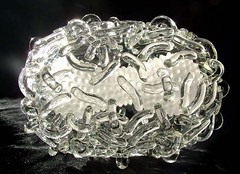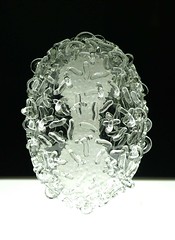 Apropos Colin Rennie’s glass sculpture of ATP synthase: visual artist Luke Jerram and glassblower Brian Jones have created these two non-coloured glass sculptures of the smallpox virus.
Apropos Colin Rennie’s glass sculpture of ATP synthase: visual artist Luke Jerram and glassblower Brian Jones have created these two non-coloured glass sculptures of the smallpox virus.
The artwork is based on a number of scientific representations of the virus, and is made in consultation with virologist Andrew Davidson at the University of Bristol.
(top right image from here, below from here)
Luke  Jerram’s artwork coincides with the 30th anniversary of the eradication of smallpox, which was once one of the most dreaded epidemic diseases but which is now an ‘extinct’ species (except for some live virus strains in ‘virological gardens’).
Jerram’s artwork coincides with the 30th anniversary of the eradication of smallpox, which was once one of the most dreaded epidemic diseases but which is now an ‘extinct’ species (except for some live virus strains in ‘virological gardens’).
There is a more interesting aspect to these sculptures than mere memorialization, however. Luke, who defines himself as “a colour blind installation artist, who fuses his artistic sculptural practice with his scientific and perceptual studies”, says that they were
designed for contemplation and to consider how the artificial colouring of scientific imagery affects our understanding of phenomena.
Similarly: before doing these sculptures, Luke — who is right now artist in residence with FACT in Liverpool — made avian flu virus and HIV sculptures, also together with virologists. The HIV sculpture work, now in the Wellcome Collection, London, was his response, he says, to the constant bombardment with coloured images of viruses in the media:
Many of these images are designed to communicate fear. The artificial colouring of images also affects what we think a virus looks like. How many people believe a virus to be bright red and yellow? (quoted from here)
The question of pseudo-colouring in biomedicine — and also its use for science communicative purposes — is a vast and very interesting topic, which would be worth an independent research project (cf this PhD project). What is its epistemic value, if any? How does the choice of different colours affect their reception? How are colour conventions negotiated? What kind of ‘presence’ do pseudocoloured images have that ‘naturally’ coloured specimens don’t?
